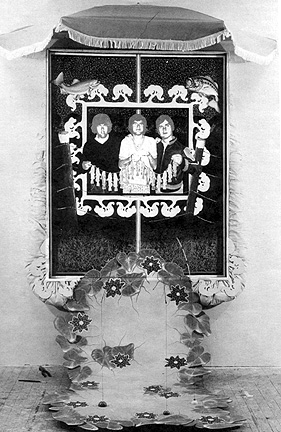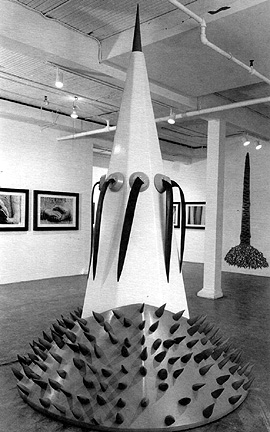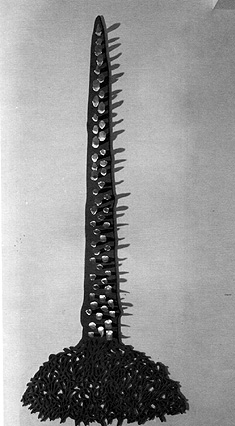
Ironically, the church which made its presence felt in so much of the sculpture of Denis Rousseau stands now in the shadow of the National Gallery. The rest of the French community in Ottawa where he grew up has disappeared, supplanted by this and other government buildings. Rousseau hasn't much attended church since childhood. What remains of it in his head are not specific ideas and pictures, but the echo of footsteps on stone, the smell of candle smoke, and the booming organ. Above him, he remembers gold-leaf stars in a blue plaster vault, symbolizing heaven.

Rousseau's sculpture tries to supply as much as it can of itself to the viewer. It doesn't sit still like most art, demanding contemplation. Instead, this work opens up (on occasion showing brightly lit teeth), and beckons us inside. All senses are brought into play. La Bébé (1976) goes as far as using the smell of talcum powder to evoke memories of infanthood. In fact it's a baby shrine, emblazoned on front with a photograph of Rousseau's first child. Opening the door in front turns on a light and illuminates different symbols of this baby's life.
These early three-dimensional works use family album pictures as a kind of seed, from which the sculpture grows. The photographs are printed without intermediate tones, emphasizing how they belong to the past. The moments shown have been washed away, never to be lived again. Yet though they have lost actuality, they gain a second artificial life through the addition of symbols and artifacts. In a sense the photos are resurrected and glorified. In another way, too much is added to them, as if the artist is afraid of being misunderstood.
Les Boys (1977) has fishing rods sticking out of it, fishing in a painted pond. Look, it seems to be saying, this actually happened. Here are the rods and an actual summer time umbrella to prove it. There are cut-outs of trees against a painted sky as if it also needed proving that there were trees and a sky back then. If included in a realistic painting, these details wouldn't mean much. But cutting them out and placing them in front, making them symbolic and palpable gives them new importance. It implies a sense that without these concrete reminders the memory will pass away.
Real shrines don't commemorate an event or person, they are supposed to embody it, presenting that thing to worshippers as still alive and active, though in a different form. Rousseau's sculptures seem resigned to the fact that their images are dead, given life only in the memory of its viewers. Two of his sculptures fold up for storage, as if meant to be taken down from the attic only on special occasions.
Sacred art is supposed to reassure, giving us all the answers. In a sense it wants us to remove our credulity along with our hats when we walk through church doors. Rousseau's profane art asks nothing but questions. Instead of getting an answer, we end up with a gap, the uncomfortable silence. We are left to work out the point on our own.
In his work of the late 1980's, the subject matter broadens out, and concurrently, the means of display becomes more elaborate, energized by video and machinery. Like most contemporary artists, Rousseau is competing for attention with the modern "miracles" of T.V. and all the other technological means society uses to comfort and placate.
This store-bought heaven does not come without its price. La Performance (1986) makes the viewer mount a raised platform and step on a blade-shaped button in order to achieve a kind of bargain basement transfiguration. Preserved bird's wings (one of the kinds of faintly disgusting objects Rousseau is fond of in his art) flap half-heartedly behind your head. You feel foolish for doing what the work has lead you into. In obeying, you have temporarily given up your free will, turning yourself into an experimental pigeon pressing buttons for a reward.
These interactive sculptures are in fact elaborate jokes, mimicking on a smaller scale the even more ambitious pranks played on us by powers in society. Étude de tentation, oeuvre inachevée (1982-84) offer a box one looks inside, only to be dazzled by a strobe flash. Not quite the revelation desired. Then you may stand in an empty alcove surround by a blue chlorinated pond, in fact playing the part of a statue inside a shrine. For your trouble, you wind up rotating on a mechanical platform, surrounded by stuffed pigeons which rotate along with you.
There are those who might find in these devices some insidious vision of Hell, where the symbols of sanctity are turned upside down and robbed of their power. Invisible mechanical demons are mocking the sacraments, in a walk-in painting by a modern Hieronymus Bosch.
Maybe not Hell, but in a sense these sculptures1 turn the gallery they inhabit into a kind of chapel, a personal version of that childhood church. Rousseau brings along the marble surfaces, and his own transmutations of the sounds and the sights which excited him then. However, as an adult now, who has learned to question, he can no longer accept them uncritically. So his churches criticize themselves, presenting miracles which are consciously fake, achieved with great grindings of gears and clickings of switches.

The surfaces are smooth and polished, just as they are in churches, also in corporate buildings which try to overwhelm with wealth and magnificence. Rousseau's surfaces, while displaying similar qualities, are only as deep as a layer of paint. His granite is made from foam rubber, and plywood is his material of choice. Yet formality and classicism, while subverted, are still paid attention. Rousseau is building a cabinet, trimmed with warm African wood, using one of his father's antiques as a basis. He also bas a piano in his studio, and classical music and opera are the sounds by which he builds his sculpture. So when rough wood appears, as it does in the arch backdropping La performance, it strikes a discordant note.
À bas la science! is the note sounded by L'installation de l'indifférence (1989). The little man inside the video shrine cries this, as he did in the 1950 Jean Renoir film Déjeuner sur l'herbe from which the clip is taken. He might as well be crying "Abolish religion!" or "Abolish all institutions!" Rousseau probably doesn't expect this prohibition to happen soon, but just hearing the cry shakes loose the hold these forces have on our heads. Precariously, the shrine is held captive atop a silver flying saucer, which bucks and weaves amid jet airplane sounds. It's trying, but failing, to achieve takeoff. This bizarre, gaudy device becomes a kind of "Hovering Dutchman," warning us seafarers on the straits of society to avoid the seductive saucers of science and religion, lest they kidnap us as well.
Banners hanging in boxes on the walls around this object once more reinforce the sense of the gallery as chapel. Interestingly, the word "chapel" derives from the word "cape"—which is what such banners originally were: vestments for a priest, turned into standards for battle. Imitating medieval patterns, the banners actually contain dense modern imagery which makes a connection between religion and war. These particular works stand on their own as art, while many of the pictures accompanying Rousseau's sculpture do not. These others, which mainly use video images snapped over years of viewing, remain appendages to the three dimensional work. They augment it, but do not exist apart from it.
Rousseau's latest sculptures do not invite the viewer to participate or operate buttons. They are self contained, switching on when they please, oblivious to being watched. In a way they control the audience, because they call attention to themselves with their sudden mechanical clatter, and people are drawn to look. Viewers might think they are taking a random walk around the floor of the gallery, but their paths are pre-determined by the whims of these insidious machines. These are all cheeky works, one (Le Désir, 1991) tremblingly obscene with its vibrating tongues of rubber, another (Le Discours, 1991 ) hatching in front of you to show those sharp teeth. The third, called Le Plaisir (1991), flails itself masochistically with rubber whip-like arms, while a tail at its base wriggles in water like an eager sperm. All of these pieces are decorated with spikes, reminding one at first of rock n' rollers' studded bracelets. But they also hint at the fat, crowded leaves in the art of an earlier Rousseau, namely the Douanier Henri. For while this exhibit is still a chapel, it is also a forest. It might be the Tulgey Wood from Alice in Wonderland, where strange beings are happened on by accident. It certainly is the Garden of Eden. A wall sculpture which is a sword and a phallus, is most importantly a tree. Its visible filigree of roots recall the cutouts of Rousseau's early memory sculptures. Called Langues de feu (1991), it lights up and wags clicking transparent resin longues, recalling the gift to the Apostles of the Holy Spirit. But this Gift of Tongues (and this piece has lots of them, running up and down its length) gives no enlightenment. Small spiked mounds (adjuncts to Le Discours) sitting against various walls, babble in tape recorded languages, also saying nothing. Rousseau intends some day perhaps to make one of these for every language on earth.

At its core Rousseau's art is not only about disconnection, or moral incitement. It begins in a desire to make objects that move and are colourful. He dislikes planning too carefully, preferring to design as he cuts, so that the end result surprises him as much as anyone. He says he wants to learn from sculpture, not simply execute the same form over and over. It pleases him that he detects a rural part of his personality in his last series of works. Their awkward motions and shiny enamel colours remind him of farm machinery. However, fearing that even his usual method is another kind of rut, he's turned to making sketches for his next batch of sculptures. The drawings are of insect-like forms, involving the patterns of wings and segments. Like most of his work of late, they all point towards the sky.
1 Not installations, Rousseau insists. He believes an installation belongs only in the site for which it was built. Anything than can be transported becomes a sculpture or an ensemble of sculptures. [back]
SOURCES:
Lorne Falk, "Denis Rousseau × Dedicated to the Memory of Our Parents" Vanguard, no. 7, Feb./Mar. 1989, pp. 10 15.
Jennifer Couelle, "Denis Rousseau Au delà du Hard Kitsch" Esse, no. 13, Autumn 1989, pp,29 31.